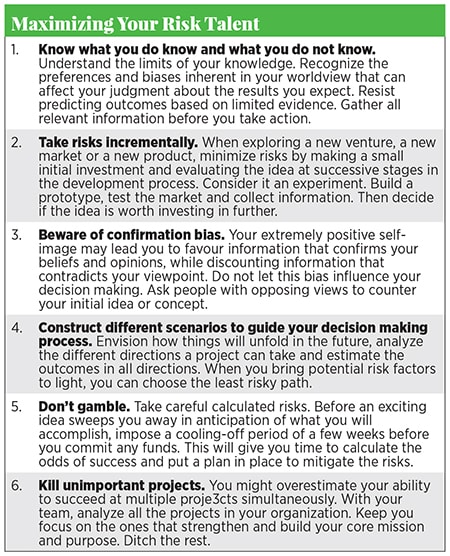How to build something great
Sangeeta Badel, an entrepreneurship expert explains how to become a builder


 Sangeeta Badal[br]Q. You believe entrepreneurship is better characterized as building, and that ‘builders’ are quite different from the rest of us. Please explain.
Sangeeta Badal[br]Q. You believe entrepreneurship is better characterized as building, and that ‘builders’ are quite different from the rest of us. Please explain.
When people talk about entrepreneurship, a stereotypical image often comes to mind: A college dropout from an Ivy League school who started a tech company in his dorm or garage and now makes billions in Silicon Valley. The problem is, it is very difficult for people to see a place for themselves in that image—so they assume that they don’t meet the criteria for entrepreneurship. That simply isn’t true.
At Gallup, we think about ‘builders’ much more broadly: A builder is anyone who starts out with a problem or an unmet need and tries to find a solution to it. It could be an actor starting up his own theatre company, rather than waiting around for roles to fall in his lap a college student who notices an unmet need in her local environment and jumps in to fill it or someone starting a non-profit to address an unmet need that they notice in their community. All of these examples—and many more—fall under our builder definition.
Q. Describe the four principles that must be addressed to build something successfully.
Most of what we hear in the media about ‘helping entrepreneurs succeed’ focuses on external challenges they face, such as lack of financing, inadequate management training or unfriendly governmental policies. But this lens fails to account for the individual differences between builders. Instead, my colleagues and I take a uniquely psychological approach and focus on unlocking the power of the individual at the centre of all this activity. When a business fails, it is not usually due to resource scarcity, organizational challenges or other external factors, it is due to the decisions and actions of the founders.
We have found that there are four principles for building successful businesses. First of all, self-awareness is critical, because your venture must be closely aligned with who you are as a person. When we work with budding entrepreneurs, we help them become aware of their capabilities, motivations and true passions in life. As individuals attain psychological clarity, they also tend to gain confidence in their ability to build something sustainable and successful.
Next, we move on to opportunity recognition. Opportunities are all around us some are visible—such as a process that needs to be improved or a gap between ‘what is’ and ‘what should be’ while others are just waiting to be discovered. That’s why the would-be builder needs to be alert to the changes taking place around him or her: Developments in technology, new regulations, even unexpected events or demographic shifts can present opportunities that no one anticipates. Cultivating ‘builder alertness’ is critically important to discovering opportunities.
Of course, an idea is worthless unless there is action behind it, so the third principle is figuring out the process of building your idea into a product—what we call activating on ideas. An effective way to do that is to create a minimally-viable solution to the problem you have chosen to focus on, test drive the idea and take the initial steps to build a customer base.
The fourth principle is building your team. As I said earlier, there is still this idea that entrepreneurship is an ‘individual sport’ where a lone genius builds something all alone. That just isn’t the case. The reality is that there is no ideal builder—just ideal teams. It is important to make sure your teams have the distribution of talent needed to build a successful venture. Image: Shutterstock[br]Q. Tell us about the three roles that are critical to every start-up team.
Image: Shutterstock[br]Q. Tell us about the three roles that are critical to every start-up team.
The first is the Rainmaker. This is the revenue generator and the main customer creator. He or she has excellent sales talent and an uncanny ability to manage risks. The second role is the Expert—an innovator with a focus on product development. This individual usually has expertise in a particular area that fuels product development. Experts tend to be highly independent and are constantly reimagining new possibilities.
The third role is the Conductor, which requires a high level of managerial talent. If a business wants to grow in scale, you need the glue that holds all of the pieces together—from hiring employees, to positioning them in the right roles, to making sure processes are set up so that the product can be delivered on time. Orchestrators have the ability to manage all aspects of the business so that it becomes a well-oiled machine.
By the way, each of these types can start or grow a venture independently but the real magic happens when the three come together on a team.
Q. Having studied many start-ups as they get off the ground, what have you learned about the path to opportunity creation?
The most important thing we have learned is that everyone can improve their ability to recognize opportunities. Becoming alert and sensitive to the shifts happening around you—whether it be shifts in the market or shifts in customer needs—is something we can learn to do.
We have identified three steps to becoming more alert to opportunities around you. The first is to start with your talents. Look at what you do in your day-to-day life and think about which particular activities lead to a very high level of engagement, genuine satisfaction or a state of ‘flow’. In most cases, you learned this activity very quickly and saw early signs of success. If all of these conditions are met, you are in your ‘talent zone’.
To discover yours, we recommend keeping an ‘opportunity journal’ for three to four weeks and recording all of your activities on a day-to-day basis. At the end of week four, go through it and you will start to recognize what really puts you in the zone. You will also notice the things that are ‘performance-drainers’. Once you identify your talent zone, you can move on to the next step, which is connecting the dots. Q. Tell us more about ‘connecting the dots’.
Q. Tell us more about ‘connecting the dots’.
As you identify one or two activities that are in your talent zone and get more involved in them, you will begin to develop awareness about the problems, gaps and issues related to each activity. This awareness can lead to ideas that can change or improve the situation.
In the book, we use an example of a college student who loved designing new recipes and cooking them for her friends. As she got more involved in doing this, she realized that her college dining services offered boring food to the students living in the dorms. She also knew that most of her friends were open to diverse food experiences. She then connected the dots between her culinary talent, the college dining environment, and her experience of dining with her friends, and an idea took shape: What if she provided her campus dining services with some unique recipes that were easy to prepare? Maybe they would be open to offering new entrees on the menu? In short, she started with her talents, was aware of her environment and connected the dots to create an opportunity.
The third and the last step on the path of opportunity recognition is to use your networks to further your idea so that you can take action on it. We suggest starting with people you trust—immediate friends, family and people you look up to, like coaches, mentors or any other individuals in your life who can be a sounding board for your ideas. Then, you not only get feedback on your idea from them, but you also tap into their connections and resources.
In the example of the college student, her academic advisor introduced her to the director of dining services via email and her mentor introduced her to a doctoral student in Nutrition Science so that she could assess the calorie and nutritional content for each proposed entrée—which strengthened her pitch to the director of dining services.
Q. Any parting advice for readers with a simmering idea?
If you have an idea that is keeping you up at night, my advice is to build a minimally viable solution to the problem you are trying to solve. Find your first customer, and test and validate your hypotheses. As indicated, your route to the solution will be influenced by who you are, so become more self-aware and in tune with your interests and strengths.
Always remember: Make time to dream big, even as you take small steps towards your goals. Some of you will build a for-profit venture, while others will build a social enterprise. Still others will build new products and services within existing companies. When you do any of these things, you create economic energy that wasn’t there before—as well as good jobs and all the things that build a growing economy. My hope is that many of your readers will ask themselves, ‘Is it time for me to build something?’
Sangeeta Badal, PhD, is the Principal Scientist for Gallup’s Building Initiative, where she is responsible for translating research findings into interventions that drive small business growth. She is the co-author with Gallup Chairman and CEO Jim Clifton of Born to Build: How to Build a Thriving Start-Up, A Winning Team, New Customers and Your Best Life Imaginable (Gallup Press, 2018).
First Published: Jul 15, 2019, 15:34
Subscribe Now